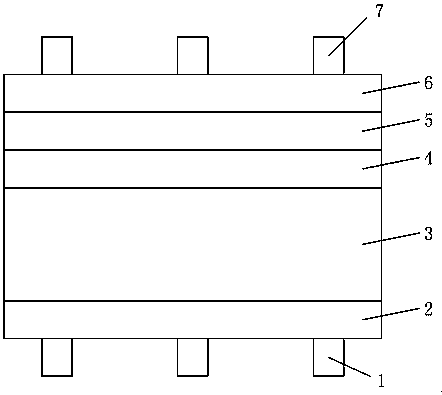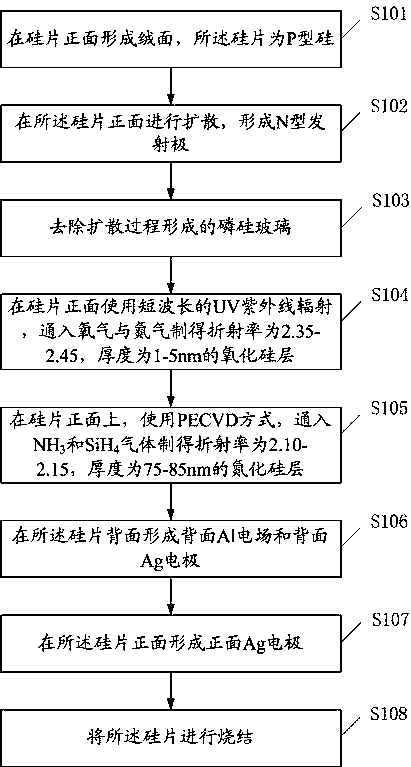A kind of anti-potential induced decay solar cell and preparation method thereof
A technology of potential-induced attenuation and solar cells, which is applied in the field of solar cells, can solve the problems of poor anti-potential-induced attenuation performance of batteries, unsatisfactory anti-potential-induced attenuation performance of batteries, and low refractive index, so as to improve battery conversion efficiency and increase Effect of resistance to potential induced decay performance
- Summary
- Abstract
- Description
- Claims
- Application Information
AI Technical Summary
Problems solved by technology
Method used
Image
Examples
preparation example Construction
[0049] Correspondingly, see figure 2 , the invention provides a method for preparing a solar cell resistant to potential-induced decay, comprising:
[0050] S101, forming a textured surface on the front surface of the silicon wafer, where the silicon wafer is P-type silicon.
[0051] The textured surface of the silicon chip adopts HF and / or HNO 3 solution to form an ideal suede structure and reduce reflectivity.
[0052] S102, performing diffusion on the front surface of the silicon wafer to form an N-type emitter.
[0053] The N-type emitter can be formed by methods such as thermal diffusion or ion implantation, wherein the diffusion of the silicon wafer is preferably made of phosphorus oxychloride.
[0054] S103, removing the phosphosilicate glass formed in the diffusion process.
[0055] Removing the phosphosilicate glass is beneficial to ensure the photoelectric conversion efficiency of the battery.
[0056] S104, using short-wavelength UV ultraviolet radiation on th...
Embodiment 1
[0067] Forming a suede surface on the front side of the silicon wafer, the silicon wafer is P-type silicon;
[0068] Diffusion is performed on the front side of the silicon wafer to form an N-type emitter;
[0069] Removal of phosphosilicate glass formed by the diffusion process;
[0070] Use short-wavelength UV ultraviolet radiation on the front of the silicon wafer, and pass oxygen and nitrogen to prepare a silicon oxide layer with a refractive index of 2.35 and a thickness of 1nm. The reaction temperature is 50°C, the oxygen flow rate is 15L / min, and the nitrogen flow rate is 10L / min, deposition time 8s;
[0071] On the front side of the silicon wafer, using the PECVD method, first pass the reaction gas NH 3 3.5 slm and SiH 4 900 sccm, the reaction time is 200 s to form the first layer of silicon nitride film; then, change the NH 3 and SiH 4 flow, the NH 3 Flow rate is set to 4.5slm, SiH 4 The flow rate is set to 500 sccm, the reaction time is 390s, and the second ...
Embodiment 2
[0076] Forming a suede surface on the front side of the silicon wafer, the silicon wafer is P-type silicon;
[0077] Diffusion is performed on the front side of the silicon wafer to form an N-type emitter;
[0078] Removal of phosphosilicate glass formed by the diffusion process;
[0079] Use short-wavelength UV ultraviolet radiation on the front of the silicon wafer, and pass oxygen and nitrogen to prepare a silicon oxide layer with a refractive index of 2.37 and a thickness of 2nm. The reaction temperature is 52°C, the oxygen flow rate is 17L / min, and the nitrogen flow rate is 12L / min, deposition time 9s;
[0080] On the front side of the silicon wafer, using the PECVD method, first pass the reaction gas NH 3 3.7 slm and SiH 4 950 sccm, reaction time 205 s to form the first layer of silicon nitride film; then, change the NH 3 and SiH 4 flow, the NH 3 Flow rate is set to 4.8slm, SiH 4The flow rate is set to 600 sccm, the reaction time is 400s, and the second layer of...
PUM
| Property | Measurement | Unit |
|---|---|---|
| thickness | aaaaa | aaaaa |
| thickness | aaaaa | aaaaa |
| thickness | aaaaa | aaaaa |
Abstract
Description
Claims
Application Information
 Login to View More
Login to View More - R&D
- Intellectual Property
- Life Sciences
- Materials
- Tech Scout
- Unparalleled Data Quality
- Higher Quality Content
- 60% Fewer Hallucinations
Browse by: Latest US Patents, China's latest patents, Technical Efficacy Thesaurus, Application Domain, Technology Topic, Popular Technical Reports.
© 2025 PatSnap. All rights reserved.Legal|Privacy policy|Modern Slavery Act Transparency Statement|Sitemap|About US| Contact US: help@patsnap.com


